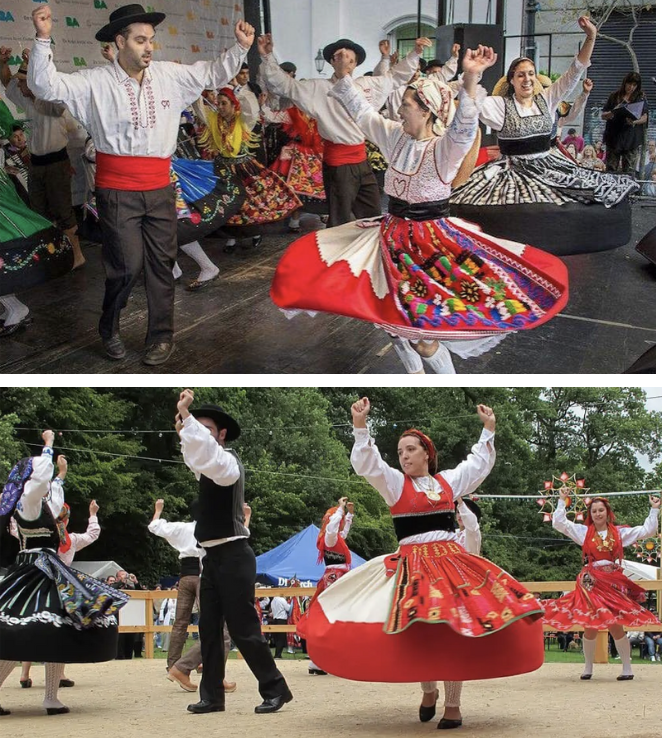The next 5 must-see popular festivals in Portugal
[post-vues]
Customs and traditions are very important in Portugal. They represent the cultural heritage and history of the Portuguese people. They are vectors of social cohesion for the entire Portuguese people. Discovering Portuguese customs and traditions during your stay in Portugal will give you an insight into the “real” Portugal, and you won’t regret it.

1 – Customs and traditions in Portugal: traditional Portuguese dances
From the north to the south of the country, traditional dances are popular and omnipresent. They are part of Portugal’s customs and traditions. They express the soul of each region. Among the most famous regional dances are :
- Chula du Douro,
- Vira from Minho,
- Corridinho from the Algarve,
- Fandango from Ribatejo,
- Bailinho from Madeira,
Corridinho d’Algarve @villasalgarve (top photo) – Chula du Douro @danceask.net (bottom photo)
But also :
- Pauliteiros de Miranda: This is a group of 8 men from the Miranda region, who dance to the sound of bagpipes, drums and castanets. They wear embroidered skirts, linen shirts, fur collars, leather boots, woollen socks and hats, and use two sticks (called “palos”) to dance.
Pauliteiros de Miranda @ncultura.pt
- Caretos de Podence: These are characters from the northeast Transmontano and Alto Douro regions, dating back to Celtic times. During Carnival, the men wear red, yellow, green or black masks made of leather, wood or brass, and brightly colored costumes with wool bangs. Their outfits are complemented by bells worn on their belts.
Caretos de Podence @lefigaro
2 -Customsand traditions in Portugal: azulejos
On the blog, on Facebook, on Instagram, I often talk about azulejos. I completely fell in love with them when I arrived here in Portugal. Azulejos are an indisputable part of Portuguese heritage.
The term azulejo comes from the Arabic word “az- zuleij “, meaning “polished stone”. Azulejos were introduced to Portugal by Spain in the 15th century, which itself was discovered by the Moors.
You’ll see them on building facades, since azulejos were originally used to protect houses from the heat: a kind of insulator. Its waterproof, hard-wearing and thermal qualities make it an ideal material for interior and exterior wall cladding in Portuguese homes.
If you get the chance, I recommend a visit to an azulejo factory to see how it’s made. It’s also in these factories that I recommend you buy some, because of the quality of the work. I really like the azulejo factory in Azeitão and the Orey store in Lisbon.
Azulejos
3 -Customsand traditions in Portugal: handicrafts
Each region has its own art, handed down from generation to generation, which forms part of the customs and traditions of Portugal. These include :
- Arraiolos rugs: Arraiolos is a village just north of Évora, where women traditionally produced rugs. These Arraiolos carpets are handmade, without looms, and are patterned after Persian and Turkish rugs. In 1511, Portugal expelled the Moors, but the inhabitants had already assimilated the knowledge of embroidery and carpet-making. They continued to produce these magnificent rugs, with many workshops based in convents. Even today, Arraiolos rugs retain the original Persian structure: large motifs symbolizing the living, four pieces representing the four elements, and various theological references. In great demand by the aristocracy in the 18th century, carpets were used to protect and decorate floors, but also to display wealth. These magnificent carpets are not inexpensive, as they are handmade, the motifs being embroidered stitch by stitch on canvas or linen.
- Portuguese filigree: a jewelry tradition from Viana do Castelo. Filigree is an ornamental work made of very fine wires and tiny metal balls, welded together to form a pattern. These pieces are easily found in northern Portugal, where they are featured on the costumes of folk dance groups and on traditional wedding dresses. If you’re passing through Viana do Castelo, I recommend a visit to the Gold Museum and the Costume Museum.
- Cork: in Portugal, you’ll find cork objects in every souvenir store. Most of Portugal’s cork oak forests ( montados in Portuguese ) are found in the Alentejo region. Cork oak is used extensively in Portugal, where half the world’s cork comes from. Cork is used to make a wide range of products, from wine bottle stoppers to bags, wallets, hats, shoes and umbrellas. Today, you can even find cork sofas!
- ” Lenços dos namorados “, which can be translated as “lovers’ scarves”: the origin of this piece is the subject of various interpretations, with the first two-coloured handkerchiefs (black and red) appearing in the mid-19th century, when, in rural areas, some men of marriageable age began wearing them as accessories (probably as gifts from their sweethearts). Legend has it that a young girl, who had feelings for a boy, saw no other way to express her love than by embroidering on scarves, confessing, in words transcribed by thread and needle, everything she felt. This is where the name “lovers’ handkerchief” comes from.
Arraiolos @lisbonneaffinitées rugs (top left) – “Lenços dos namorados @portugalenfrançais (top right) – Portuguese watermark @imagesofportugal (bottom left) – Cork @monviti (bottom right)
4 – Customs and traditions in Portugal: Fado
Fado is the symbol of customs and traditions in Portugal. It’s a musical genre that dates back to the 1820s. It is characterized by sad themes that speak of fate, disappointment in love, sadness, unhappiness, the lives of sailors and fishermen, and above all, saudade. Saudade, that untranslatable word. Saudade is a kind of longing, conveying a complex mixture of nostalgia, sadness, pain, happiness and love.
There are two main varieties of Fado, named after the two cities where it was traditionally sung: Lisbon and Coimbra. The Lisbon style is the more popular, while the Coimbra style is considered more refined. Modern Fado is popular in Portugal. The best-known fadistas are Amália Rodrigues, Carminho, Mariza and Ana Moura.
Fado is a unique genre of music, traditionally sung with a single voice and accompanied by a guitar. Fado came to public attention in the 1930s and 1940s, mainly thanks to Amália Rodrigues. It has been a UNESCO World Heritage Site since 2011.
Fado @istock
5 –Customs and traditions in Portugal: canteAlentejano
Totally different from fado, captivating and unique, cante alentejano was recognized as an intangible cultural heritage of humanity by UNESCO in 2014. Cante Alentejano uses no musical instruments, the voice being the only component of this tradition. The lyrics speak of feelings and moments of daily life, and the singing became particularly popular from the end of the 19th century onwards.
Cante alentejano (polyphonic song from Portugal’s Alentejo region) is similar to American gospel music. It focuses on the harsh life in the fields of Alentejo, an agricultural region that is arid in summer and very cold in winter.
Cante alentejano @nit.pt
6 –Customs and traditions in Portugal: the roosterof Barcelos
Located on the route to Santiago de Compostela, Barcelos is a small town in northern Portugal. The town is best known for its famous rooster legend. The rooster has become one of the symbols of Portugal.
Legend has it that several crimes took place in Barcelos at the time, but no culprit was ever caught. One man, on his way to Santiago de Compostela, was found guilty by the court without evidence. He claimed his innocence, and went to see the judge. Seeing a rooster near him, the accused told the judge: “It’s just as true that I’m innocent as that your cooked rooster will rise and crow when I’m hanged! On the day of the man’s execution, the rooster crowed and the judge realized that the accused was indeed innocent. The judge ran to the place where the man had been hanged. As a result of the knot being tied incorrectly, the man escaped execution, was found innocent and set free.
Rooster of Barcelos @livingtours
In conclusion
The customs and traditions in Portugal mentioned in this article are just a sample of all those that exist in Portugal. These are truly part of Portugal’s heritage, and it’s well worth getting to know them. There are also the festivities and romarias, which are widely celebrated and deeply rooted in Portuguese customs and traditions. To find out more about these popular festivals, I invite you to read or reread my article: Popular festivals in Portugal
Join us on social networks!
- Facebook group “Amoureux du Portugal”,
- Vivre au Portugal” Facebook page
- Instagram ” Living in Portugal
Articles Populaires
dernières annonces

2 bedroom apartment with sea view, 10km from Lisbon and 2km from the beaches
Rua da Bica, 103Discover this magnificent 2 bedroom apartment with views of Arriba Fóssil and the sea, 2km…

Duplex apartment with sea view 15 minutes from Lisbon
rua Santa Teresa 7Bedroom + duplex apartment with sea view and 15 minutes from Lisbon.

Single-storey house with swimming pool
Just a few meters from the magnificent bay of São Martinho do Porto, lies this…

Condominium apartments facing the sea
São Martinho do PortoBeautiful apartments in São Martinho do Porto “Janela da Baía”! Located in the heart of…

Villa already finished and ready to move in: 4-suite bungalow on 750m2 plot in a quiet area of Azeitão
Rua de ParisHouse already finished and ready to move into! Close to shops and services, quick access…

Magnificent house with basement, indoor and outdoor pool in Verdizela/Aroeira
Verdizela/AroeiraNew turnkey project: magnificent single-storey villa, 498m2 in surface area, high-end finishes on a 1875m2…

Luxury apartment on the edge of a nature reserve
Your modern, spacious apartment between the beach and Lisbon’s capital. – Beach 5min – Golf…

House T3 1 10 min from Lisbon and 5 min from the beaches
PêraREADY TO MOVE IN! New T3 1 ready-to-live-in house in a quiet, rural neighborhood with…

4 bedroom villa with pool and jacuzzi in Aroeira
rua são miguelModern, minimalist architect-designed house with exceptional details in a quiet location in Aroeira 2-storey house…
Inscrivez-vous à notre newsletter
Recevez chaque mois les derniers articles de notre blog "la vie au Portugal" et notre sélection de biens immobiliers à vendre.






















